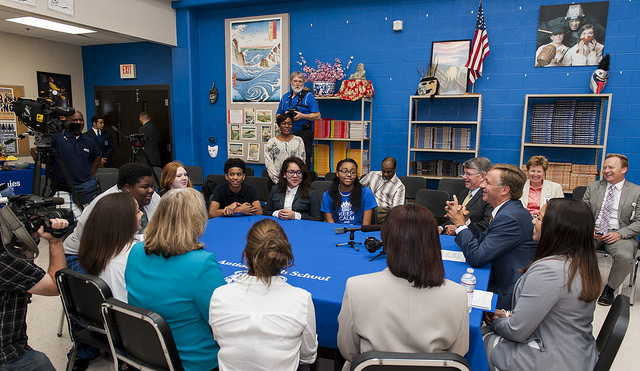You have /5 articles left.
Sign up for a free account or log in.
NASHVILLE -- Bill Haslam wasn’t sold on the idea of two years of tuition-free community college when he first heard it.
That was back in 2008, when the Republican, now governor of Tennessee, was Knoxville’s mayor. Mike Ragsdale, who was then mayor of the surrounding Knox County, made the pitch to Haslam.
Ragsdale was among a group of local leaders who were trying to create a private scholarship to cover the tuition costs for high school graduates who wanted to attend community and technical college.
“It would be fair to say that he was skeptical,” says Ragsdale, who remembers Haslam telling him “it wasn’t the right time, probably just to try not to hurt my feelings.”
Ragsdale wasn’t deterred. He and others formed a nonprofit group that year to begin offering the scholarships.
Haslam didn’t take long to change his mind about the project.
“They kind of pulled me along for the ride,” he says during an interview this spring. “Some local business folks started pushing that, and then I saw how much it worked.”
In its first six years the organization, which is now called tnAchieves, has supported nearly 12,000 students. The scholarships cover any gaps in tuition for two years -- meaning costs not covered by federal aid or other sources. (Annual tuition is $4,000 per year at Tennessee’s community colleges.) Recipients are paired with a mentor, and must complete community service projects.
The group now operates in 84 counties across the state. It has helped some Tennessee community colleges increase the number of lower-income students who enroll and, thanks to the mentors and other academic supports, earn a credential. For example, Pellissippi State Community College, which is located in Knox County, has increased its degree production by 90 percent since 2008. And while the scholarship program hasn't driven all of that increase, it's certainly helped.
The demand for tnAchieves has been as impressive as its results. It received 14,000 applications for this academic year.
Bill Haslam
Republican governor of Tennessee
Born in Knoxville in 1958
Attended Emory University
Worked as executive for Saks Fifth Avenue and the Pilot Corporation, which his father founded
Was Knoxville’s mayor from 2003 to 2011
Elected governor in 2010 and facing reelection this year
Haslam featured tnAchieves during his inauguration as governor, in 2011, by holding a benefit concert for the program. Then, beginning last year, he brought in Randy Boyd as an unpaid adviser on college completion. The governor knew Boyd well from his time as mayor. Boyd, the founder and chairman of a Knoxville technology company, played a major role in creating and sustaining tnAchieves.
Government, according to Haslam, is “about choosing between good things and other good things.”
Boyd says that philosophy was behind his friend’s early skepticism about the private scholarship. But the governor later tasked Boyd with taking that idea and making it great.
“When he came on board,” Ragsdale said, “he came on board in a big way.”
Following a Democrat
People here say it's no surprise Haslam overcame skepticism to embrace an idea. They say the popular governor is pragmatic about pursuing strategies that work, even if he didn’t come up with them or back them initially. And Haslam’s decision to run with the idea for a community college scholarship wasn’t the first time he checked his ego and followed the lead of others in higher education policy.
For example, he has been a strong supporter of Tennessee’s performance-based funding system, which predates his arrival as governor. The formula is among the nation’s most aggressive. All state support for higher education, minus some operational funding streams, is tied to performance measures such as graduation rates, student progress milestones and remedial education success rates.
And while many Republican governors use performance measures mostly as an excuse to cut education budgets, Haslam ties new funding streams to his reforms.
“Republicans believe in outcomes and accountability. It should fall right into our sweet spot,” he says. “The challenge is always going to be, are you willing to put your dollars where your mouth is.”
Philip Bredesen was the state’s Democratic governor just prior to Haslam’s term. He championed the 2010 Complete College Tennessee Act, which expanded the state’s previous performance-funding model.
“My predecessor, Governor Phil Bredesen, did a wonderful job of raising expectations for our state and creating momentum,” Haslam said this spring to a room full of education reporters. “And I felt like my job was to take that momentum and then actually put it into practice.”
Haslam has tried to take Bredesen’s college completion push to the next level with his Drive to 55 initiative. Created last year, the package of policies is organized around the goal of increasing the number of Tennesseans who hold a college degree or certificate to 55 percent by 2025 (about one-third do now).
For example, the Drive to 55 includes a scholarship aimed at the nearly one million Tennesseans who hold some college credits but no credential. Under the so-called Tennessee Reconnect, those adult students can earn a certificate tuition-free at one of the state’s 27 colleges of applied technology.
Bredesen also proposed a modest free community college plan. But it never took hold.
Haslam went further with a proposal that would become the crown jewel of his Drive to 55.
 The idea took more than a year to develop. Boyd took the lead, drawing on his experience with tnAchieves, which he calls a six-year pilot program.
The idea took more than a year to develop. Boyd took the lead, drawing on his experience with tnAchieves, which he calls a six-year pilot program.
In February Haslam announced the Tennessee Promise, a statewide plan for two years of tuition-free community college for all Tennessee high school graduates. It applies to the state’s 13 community colleges and the technical colleges.
The proposal included a fifth free semester, because 70 percent of incoming community college students in the state require remediation. Like tnAchieves, it seeks to match up each qualifying student with one of thousands of volunteers who will serve as mentors. And recipients would be required to complete eight hours of community service.
The concept, which drew national headlines, was for a so-called “last dollar” scholarship. That means students could only draw down the Tennessee Promise money after all other forms of financial aid -- such as Pell Grants -- had been tapped.
Even so, it wasn’t going to be cheap. So Haslam tackled the funding question up front.
He estimated an initial annual price tag to the state of $34 million. To cover that cost, and do so in a way that would be protected from future budget cuts, Haslam called for the creation of a self-sustaining $300 million endowment. He wanted to take the money from a lottery fund. The state also later chipped in another $47 million.
Haslam took a similar approach with a program that sends community colleges into high schools to help more students get ready for college-level math. He funded the project last year with $1.1 million from the Drive to 55’s budget. The early results have been promising -- 67 percent of students who went through the program have been able to avoid remedial math, saving millions in tuition. Haslam wants funding to keep pace with its rapid expansion. So this year the state increased support for the program to $2.5 million.
Real money rarely follows bold higher education policy pronouncements. For example, politicians in many states have imposed tuition cuts or freezes on public colleges. But they rarely increase state support to make up for the lost revenue, effectively forcing budget-slashing. And the resulting cuts often affect course sections and student advising, which can be important for students to graduate on time.
Policy-makers in Oregon and Mississippi have also mulled plans for tuition-free community college, but have so far failed to find the funding. And a proposal by a Texas Democrat, which is modeled on Tennessee's program, probably faces long odds of getting the estimated $2 billion it would need to create an endowment.
Yet Haslam was able to lock down years of funding for the Tennessee Promise during a tight budget year.
Meeting Resistance
Creating the endowment wasn't easy.
The lottery money had been earmarked (although it was not currently being used) for the state’s HOPE scholarship fund. Students could use that money to attend four-year institutions in Tennessee. And Haslam also wanted to lower the award amount for students who attended the state’s four-year institutions under the scholarship.
U.S. Rep. Steve Cohen is a Democrat who represents Memphis. He led the creation of the HOPE fund during his time as a state senator. He is not a fan of Haslam’s Tennessee Promise.
“I worked for 20 years to make the lottery happen,” he says. “The hardest thing about education policy is getting the money. He just poached money.”
Cohen also says the community college scholarship will encourage students who could succeed at the four-year level to instead attend community college.
For that reason, as well as the scholarship cut, public university leaders were also less than thrilled by the proposal. Tennessee’s influential private colleges were critical of the plan as well, in part because the HOPE trim affected them, too.
Haslam's plan hinged in part on bringing more people into higher education. Yet while critics talked in public about the scholarship cuts, privately many leaders of non-elite four-year institutions talked about fears that they would lose students to community colleges.
Both chambers of the Legislature eventually held up the bill, mostly over concerns about the redirected lottery scholarship money.
Haslam didn’t back down. But he did talk with critics of the plan.
Claude Pressnell is president of the Tennessee Independent Colleges and Universities Association. His group had concerns initially. But he said his members were impressed by the governor’s willingness to negotiate.
One Thursday this spring, Haslam began personally calling private college presidents around the state to ask how the proposal could be tweaked to their liking. They suggested a smaller reduction in the HOPE scholarship awards.
“We agreed to a compromise by Monday,” Pressnell said. “He listened.”
Haslam had proposed to cut the HOPE scholarship amount for freshmen and sophomores at private and public, four-year universities by $1,000, reducing the annual award to $3,000. But he agreed to reduce that reduction by half, so students will be able receive $3,500 annually for their first two years of college.
In April the Legislature overwhelming passed the final bill. The Tennessee Promise began accepting applications this month. Students will begin attending two-year colleges in the state tuition-free this fall. Haslam has said he expects overall enrollment in Tennessee’s public colleges to increase by 15 percent eventually.
That potential increase to the pipeline would help ease any pain to public universities in the state, because more students would be transferring from community colleges to four-year institutions.
Tom Rakes, president of the University of Tennessee at Martin, said his institution may shift some of its student recruiting strategies. But he said the university has strong transfer agreements in place with nearby community colleges.
“We may lose some students the first year or two,” said Rakes, adding that “I think we can manage.”
Boyd says the work on the Tennessee Promise has hardly begun. “All we’ve done is the first two percent.”
Getting it right is crucial, says MaryLou Apple, president of Motlow State Community College. “There is just a lot riding on this,” she says. “It is truly a chance to transform your community.”
Haslam is unlikely to lose interest in the Tennessee Promise or the rest of the Drive to 55, as he appears to be headed for a second term after a likely victory in this fall’s election.
“I think it’s his legacy,” says Boyd.
Symbolism and Jobs
Workforce development was a big part of Haslam’s interest in helping more Tennesseans pay for community college.
The former corporate CEO still speaks the language of business, albeit the folksy Tennessee version instead of Wall-Street slick. Haslam stresses that government’s role is to help the private sector create and fill jobs. And he hears often from business leaders about the state’s skills gap.
“We are not coming anywhere close to having the trained level of workforce that we need here,” says Haslam, “either in quantity or quality of workers.”
Richard Laine, who directs the education division of the National Governors Association, said Haslam has been particularly successful in making higher education a budget priority. He’s done so by arguing that state support pays off for the economy as well as for students.
“He’s not doing education reform just for the sake of it,” Laine says. “He’s doing it for the workforce and the state economy.”
Haslam, however, doesn’t sound like a stereotypical Republican when he talks about the Drive to 55. He says the program’s root aims are trying to correct growing income inequality and the “cycle of poverty.”
Likewise, Haslam says the Tennessee Promise sends a powerful message to high school students that college is for them, even if they are low-income and the first in their family to consider going to college. And one of the best ways to get people’s attention, he says, is to make something free.
“A lot of battles turn into left versus right,” he says. “It doesn’t always work that way in education.”
Sparking a National Debate
The Tennessee Promise has been an attention-grabber. It dumped fuel on a national debate about government picking up more of the tab for a public college education. For example, an editorial Scientific American published last week called for other states to follow Tennessee’s lead in making community college tuition free. The magazine said the state seized the “national spotlight as an educational innovator.”
In August Haslam began touting the scholarships in visits to Tennessee high schools. But he already had received plenty of interest in the program during his travels around the state.
“That’s the one thing that I’ve done since we’ve been in office that resonates with people of all walks of life,” he says. “We’ll actually change, I hope, the aspirational level of a lot of high school students.”
Many higher education experts applauded the program, particularly for the signal it sends about the value of college education. Some, however, worried about whether the money might have been better-spent on a more targeted scholarship. They said that by not focusing on the neediest students, the Tennessee Promise will benefit some students who could pay for community college without taking on debt.
Others pointed out that the scholarship won’t cover the substantial transportation and other costs of living that can be a barrier for lower-income students. And some pointed to research that has found that students are less likely to earn a four-year degree in the long run if they first enroll at a community college.
Defenders of the Tennessee Promise, however, say it is about expanding badly needed college access in the community college sector and closing the state’s yawning workforce training gap. Haslam says the job market isn’t going to get easier for the two-thirds of Tennesseans who lack a college credential.
“The world’s already moving there, to requiring more training,” he says. “We’re going to have to fight as hard as we can just to keep up.”
In addition, Haslam says community colleges have been relatively underfunded. He uses the example of visiting a welding class at a two-year college that had a 100 percent job placement rate. Yet the class was small because of the college’s budget limitations.
“We haven’t done a good job historically as states in terms of how we allocate capital in higher education,” he says. “If immediately we’re getting jobs for every Tennessean that completes a welding class, we might need to expand the capital that goes to welding classes.”
However, in a rare statement for a politician, Haslam also cautions about focusing too much on job training.
“Higher education does have a function beyond just having more people walk across the stage with a sheepskin,” he says. “The thing I worry about is how do we make certain we don’t lose all the other benefits of higher education in our push toward what could be seen as a very utilitarian measure?”
Results First
While that concern may be valid, Tennessee has built flexibility into its college completion push. The state is tracking how the hodgepodge of programs are working, and is willing to revise them to try to get better results.
Furthermore, Haslam’s approach of finding ideas that have actually worked and are often generated by academics -- like the remedial math program -- means Tennessee is less ham-handed with its policy fixes than some other states have been.
This June Haslam brought in Mike Krause to lead the Drive to 55 and Tennessee Promise. Krause was formerly the assistant executive director for academic affairs at the Tennessee Higher Education Commission.
Krause says the key is to strike a balance between big ideas and small-scale execution. He compares the Drive to 55 to a large-scale military operation, which he knows a bit about. Krause served eight years in the U.S. Army, including three combat tours in Iraq, where he earned the Bronze Star Medal.
He says the program “at its core, is a logistics effort.” But one with a unifying central goal. “Everybody is pointed in the same direction. It’s easier when you have that North Star.”
Rapid expansion can also be part of the job. Take the remediation project, which is dubbed Seamless Alignment and Integrated Learning Support (SAILS). It began in 2012, with four community colleges going into local high schools to run math labs for students so they will be better prepared for college-level math.
The initial effort included 600 high school students. Pass rates were high -- 83 percent in one college’s group. And fully one-quarter of participants completed a credit-bearing, college-level math course while they were still in high school.
That’s when Haslam stepped in with $1.1 million in state funding. That allowed more colleges to join. They reached 8,400 students last year across Tennessee, saving the dual-enrolled students $6.5 million in tuition money. This year Krause says 13,700 students will participate.
“We are getting very close in Tennessee to effectively ending the need for remedial math,” Krause says.
Haslam acknowledges that his array of higher education projects face an array of complex challenges. Getting to the 55 percent goal will be a stretch. But some people who work in higher education around the country wouldn’t mind seeing him bring his policy approach to the national scene. And pundits have discussed the governor as a potential Senate or even presidential candidate.
For his part, however, Haslam seems content focusing on Tennessee.
“Ultimately I think governors are about solving problems. It’s one of the great things about this job versus being in Congress,” he says. “There are a whole lot of things better about this job than being in Congress. But one of those is, ultimately, we should be judged on results.”




